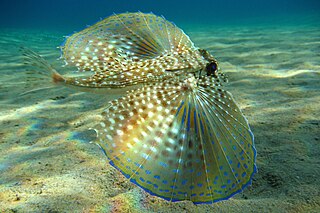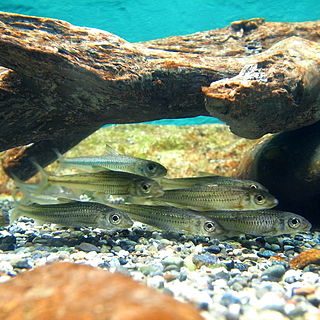
Mussel is the common name used for members of several families of bivalve molluscs, from saltwater and freshwater habitats. These groups have in common a shell whose outline is elongated and asymmetrical compared with other edible clams, which are often more or less rounded or oval.

Bivalvia, in previous centuries referred to as the Lamellibranchiata and Pelecypoda, is a class of marine and freshwater molluscs that have laterally compressed bodies enclosed by a shell consisting of two hinged parts. As a group, bivalves have no head and they lack some usual molluscan organs, like the radula and the odontophore. The class includes the clams, oysters, cockles, mussels, scallops, and numerous other families that live in saltwater, as well as a number of families that live in freshwater. The majority are filter feeders. The gills have evolved into ctenidia, specialised organs for feeding and breathing. Most bivalves bury themselves in sediment, where they are relatively safe from predation. Others lie on the sea floor or attach themselves to rocks or other hard surfaces. Some bivalves, such as the scallops and file shells, can swim. The shipworms bore into wood, clay, or stone and live inside these substances.

Callista chione, the smooth clam, is a rather large, temperate, marine, bivalve mollusc that inhabits sandy bottoms or with small pebbles in clean waters down to about 200 m from the British Isles to the Mediterranean. The shell can reach up to about 110 mm Ø, its outer side is smooth and ranges from light greenish creamy colour to medium brown, probably varies to match the background; the interior is white to soft pink. The concentric and radial growth lines are easily seen. Callista chione is edible, different dishes are prepared throughout the Mediterranean in Spain, Italy, France, the Balkan and the Maghreb countries.
A molluscivore is a carnivorous animal that specialises in feeding on molluscs such as gastropods, bivalves, brachiopods and cephalopods. Known molluscivores include numerous predatory molluscs,, arthropods such as crabs and firefly larvae, and, vertebrates such as fish, birds and mammals. Molluscivory is performed in a variety ways with some animals highly adapted to this method of feeding behaviour. A similar behaviour, durophagy, describes the feeding of animals that consume hard-shelled or exoskeleton bearing organisms, such as corals, shelled molluscs, or crabs.
Rhodeus amurensis is a temperate freshwater fish belonging to the Acheilognathinae subfamily of the family Cyprinidae. It originates in the Amur River and Lake Khanka in Asia, and is found in China and Russia. It was originally described as Pseudoperilampus lighti amurensis by B.B. Vronsky in 1967, and has also been referred to in scientific literature as Rhodeus lighti amurensis.

The Kyushu bitterling is a temperate freshwater fish belonging to the Acheilognathinae of the family Cyprinidae. It originates on Kyushu Island in Japan. It was originally described as Acanthorhodeus atremius by Jordan & Thompson in 1914. The fish reaches a size of up to 6 cm (2.5 in), and is native to freshwater habitats with a pH of 6.8 to 7.8, a hardness of 20 DH, and a temperature of 10 to 25 °C.

Light's bitterling is a temperate freshwater fish belonging to the subfamily Acheilognathinae of the family Cyprinidae. It originates in Russia and China, from the Amur River basin to southern China. It was originally described as Pseudoperilampus lighti by H.W. Wu in 1931.
Rhodeus pseudosericeus is a temperate freshwater fish belonging to the Acheilognathinae subfamily of the family Cyprinidae. It originated in the Namhan River system in the Gyeonggi-do and Gangwon-do provinces of Korea. It was originally described as Acanthorhodeus atremius by Jordan & Thompson in 1914. The fish reaches a length up to 6.1 cm (2.4 in). When spawning, the females deposit their eggs inside bivalves, where they hatch and the young remain until they can swim.
Rhodeus sciosemus is a subtropical freshwater fish belonging to the Acheilognathinae subfamily of the family Cyprinidae. It originates in inland rivers in Japan. It was originally described as Acanthorhodeus sciosemus by Jordan & Thompson in 1914. When spawning, the females deposit their eggs inside bivalves, where they hatch and the young remain until they can swim.

Rhodeus suigensis is a temperate freshwater fish belonging to the Acheilognathinae subfamily of the family Cyprinidae. It originated in inland rivers in Japan and the Korean peninsula. It was originally described as Pseudoperilampus suigensis by T. Mori in 1935, and has also been referred to as Rhodeus atremius suigensis in scientific literature. The species was listed as endangered in 1994 by the World Conservation Monitoring Centre, but in 1996 was relisted as "data deficient". When spawning, the females deposit their eggs inside bivalves, where they hatch and the young remain until they can swim.

Rhodeus uyekii is a temperate freshwater fish belonging to the Acheilognathinae sub-family of the family Cyprinidae. It originates in inland rivers in South Korea. It was originally described as Pseudoperilampus uyekii by T. Mori in 1935.

Acheilognathus rhombeus is a temperate freshwater fish belonging to the Acheilognathinae sub-family of the family Cyprinidae. It originates in Japan and the Korean Peninsula. It was originally described as Capoeta rhombea by Temminck & Schlegel in 1846. It is the type species for the genus Acheilognathus.
Freshwater bivalves are one kind of freshwater mollusc, along with freshwater snails. They are bivalves that live in fresh water as opposed to salt water, which is the main habitat type for bivalves.

The Gobiiformes are an order of fish that includes the gobies and their relatives. The order, which was previously considered a suborder of Perciformes, is made up of about 2,211 species that are divided between seven families. Phylogenetic relationships of the Gobiiformes have been elucidated using molecular data. Gobiiforms are primarily small species that live in marine water, but roughly 10% of these species inhabit fresh water. This order is composed chiefly of benthic or burrowing species; like many other benthic fishes, most gobiiforms do not have a gas bladder or any other means of controlling their buoyancy in water, so they must spend most of their time on or near the bottom. Gobiiformes means "Goby-like".

The flying gurnard, also known as the helmet gurnard, is a bottom-dwelling fish of tropical to warm temperate waters on both sides of the Atlantic. On the American side, it is found as far north as Massachusetts and as far south as Argentina, including the Caribbean and Gulf of Mexico. On the European and African side, it ranges from the English Channel to Angola, including the Mediterranean. This is the only species in the monotypic genus Dactylopterus. Similar and related species from the genus Dactyloptena are found in the Indian and Pacific Oceans.

The C-O sole is a flatfish of the family Pleuronectidae. It is a demersal fish that lives on flat bottoms and rocky areas at depths of between 18 and 350 metres. Its native habitat is the temperate waters of the eastern Pacific, ranging from Sitka, Alaska in the north to San Quintín, Baja California in the south. It can grow up to 36 centimetres (14 in) in length.

The stone flounder is a flatfish of the family Pleuronectidae. It is a demersal fish that lives on sandy and muddy bottoms in coastal areas at depths of up to 150 metres (490 ft). Its native habitat is the temperate waters of the northwest Pacific, from Japan to the Kuril islands, Sakhalin, Korea, northern China and Taiwan. It is oceanodromous and is found in salt, brackish and fresh waters. It can grow up to 50 centimetres (20 in) in length, and may reach 12 years of age.

Acheilognathus macropterus is a species of cyprinid fish native to China and northern Vietnam. It grows to a length of 27.5 centimetres (10.8 in) SL.

Squalidus is a genus of cyprinid fish that occurs in eastern Asia. There are currently 14 described species in this genus.

The Khanka gudgeon is a species of cyprinid, an East Asian freshwater fish that occurs from the Amur basin in Russia, through China, Mongolia and Japan, to Vietnam. It reaches up to 13.6 cm (5.4 in) in total length.















